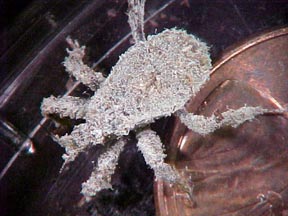I must have leveled up recently because I just unlocked a new fear. The masked hunter bug.
I managed to make it this far into my life without being aware that these things existed. Now that I know, you also have to know. You’re welcome!
So, how did I come across this interesting creature?
Well, picture this. You’re minding your own business in the kitchen. Maybe you’ve got some music playing. It’s a wonderful day. Nothing can go wrong. False. Something is about to go horribly wrong.
You’re thirsty. That happens. That’s normal. So you open the cupboard and reach for a glass. You don’t see it. But it’s there. A bug. It’s got six legs. It’s small, but also a little too big for what you deem to be a comfortable size for a bug. It can fly. You reach for a cup. The bug doesn’t like that. The bug doesn’t like that at all.
It spreads its wings and flies directly at your face. You scream. You back up, but it’s still flying at you. It’s relentless. You scramble out of the kitchen and to your front door. You manage to make it outside, slamming the door behind you, but your house is lost now. It belongs to the bug.
Just kidding. That’s not what happened at all. I found the bug in a pot and it couldn’t escape so I put the whole pot outside. The bug never actually flew, but it did have wings, so I’m not 100% sure why it didn’t leave the pot. I left the bug outside in the pot until I could figure out what it was.
An internet search brought up two options. One was a masked hunter. The other was a kissing bug. There was a brief moment of panic where I thought maybe I had a kissing bug infestation.
Kissing bugs, also known as conenose bugs, are large, blood-sucking assassin bugs that transmit a disease known as Chagas disease. Lucky for us, there haven’t been any reports of them in Michigan.
I have now confirmed the bug I found was a masked hunter, or Reduvius personatus. Masked hunter bugs are found throughout the U.S. and southern Canada. It is believed they were introduced into the U.S. from Europe in the late 1800′s.
According to Nathaniel Walton with MSU Extension, the masked hunter belongs to the insect order Hemiptera. All the Hemiptera have a mouthpart designed to penetrate surfaces and feed on liquid foods. Assassin bugs’ mouthparts are short and stout so they can penetrate the exoskeletons of other insects. They eat flies, carpet beetles, mealworms, and bed bugs.
“Once it has penetrated the prey’s exoskeleton, the mouthpart injects toxic saliva to break down the internal organs and other tissues of the victim. Finally, as though it were a tiny juice box, the assassin bug sucks the contents from the prey insect’s body,” Walton wrote.
The photo below is from Howard Russell and shows a masked hunter nymph with its camouflage intact.

The nymphs camouflage themselves to help them hide from prey and predators. They are covered in tiny hairs that catch and hold dust, lint and other small debris. An adult masked hunter is dark brown or black and about 3/4 of an inch long.
Think of the masked hunter as a roommate. One that might bite you if you bother it. They prefer to live in homes where it’s safe and dry and they can hunt small insects. They hunt at night.
“The masked hunter prefers dry habitats and therefore is usually found only indoors and other protected sites. This does not mean they are only found in the living area of the house, but it is possible they found their way in from attics and crawlspaces where their prey (other insects) may be plentiful,” MSU entomologist Howard Russell wrote.
The masked hunter I found ended up being relocated to my shed. There are a lot of bugs out there that I despise. If you find a masked hunter in your home, it’s probably best to not bother it too much. Their mouthparts can penetrate human skin and they will bite in self-defense.
You can learn more about masked hunters and other assassin bugs by checking the Insects in the Garden, Assassin Bugs, and Masked Hunter articles through the MSU Extension.
This article first appeared in the Morning Report Newsletter, sign up for it here. The Morning Report Newsletter is a daily newsletter that includes information to launch your day with what you need to know.